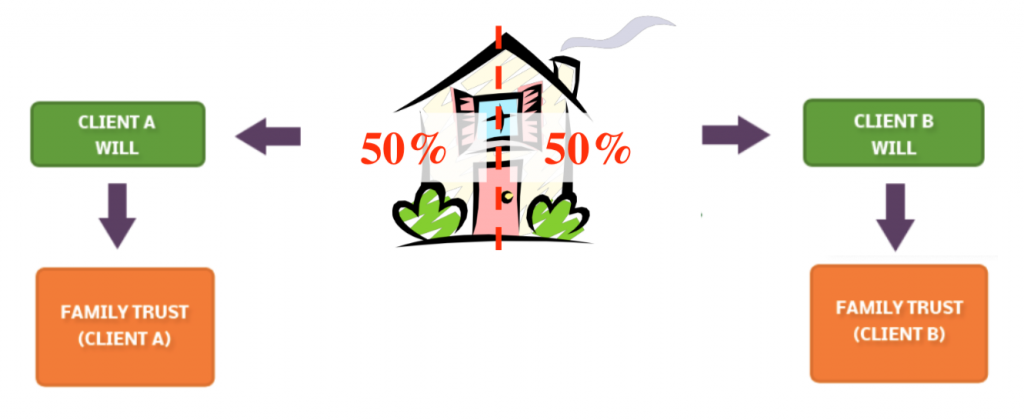Typical Existing Planning for a couple:

- House owned Jointly. When one partner dies the home is then owned solely by the Survivor
- Following first death, should the surviving spouse/partner need Care then the whole estate including the family home would be assessed to pay for the cost of that Care … amongst other threats.
Where there is no will, or couples have only a basic will/mirror wills in place, your assets are exposed to the following risks:
- Care Costs Following first death, should the surviving spouse/partner need Care then the whole estate including the family home would be assessed to pay for the cost of that Care.
- Marriage After Death (MAD) On first death all the assets are then solely owned by the surviving spouse partner. What if the surviving spouse/partner marries? The inherited estate could be lost to the spouse, disinheriting your children.
- Creditors or Bankruptcy If the surviving spouse/partner were to be subject to Creditor Claims/Bankruptcy then the inherited estate is fully at risk.
On second death there are further risks to the estate you wished your loved ones to benefit from:
- Divorce If your children/chosen Beneficiaries are subject to Divorce proceedings then half of what you intended them to receive is at risk of Divorce settlements.
- Generational Inheritance Tax IHT On second death the remaining estate is likely to be directed by the Will to the Beneficiaries. This then adds to the Beneficiaries’ estates and could impact their own Inheritance Tax.
- Their own future Care Costs If the inheritance has been passed to your chosen Beneficiaries, these assets could later be assessed for their own Care Costs.
- Creditors or Bankruptcy Similarly, if any of your Beneficiaries are subject to Creditor Claims/Bankruptcy then the inherited estate is fully at risk.
Our Solution

- On first death, the deceased’s share of the property is passed into their Family Trust via their Will.
- The surviving partner continues to live in the property and is still able to move home if they choose to do so.
- In the event of the surviving partner entering care, they only own half a share of the house. Section 7.019 of the CRAG regulations confirms that the value of a half share of a house is effectively NIL.
The beneficiaries have the full benefit of the Trust assets, but it does not enter their estate. They are also protected from the following:
- Care Holding the assets in the Trust ensures that they do not add onto the Beneficiaries’ own estates and so cannot be assessed for their Care costs.
- Creditors or Bankruptcy Similarly, if any of your Beneficiaries are subject to Creditor Claims/Bankruptcy then their inheritance would not be exposed to these claims.
- Further or Generational IHT Holding the assets in the Trust ensures that they do not add to the Beneficiaries’ estates and impact on their own Inheritance Tax.
- Marriage After Death (MAD) Placing half of the family home and other assets into a Trust on first death ensures that, should the surviving spouse/partner marry in the future, those assets cannot be taken into the marriage and removes the threat of your own children being disinherited.
- Divorce Placing the assets into Trust ensures that, if your children/ chosen Beneficiaries are subject to Divorce proceedings then what you intended them to receive is protected from any Divorce settlements.
- Residence Nil Rate Band (RNRB) Our trusts ensure that if there are lineal descendants as beneficiaries, the trust will still qualify for the RNRB.